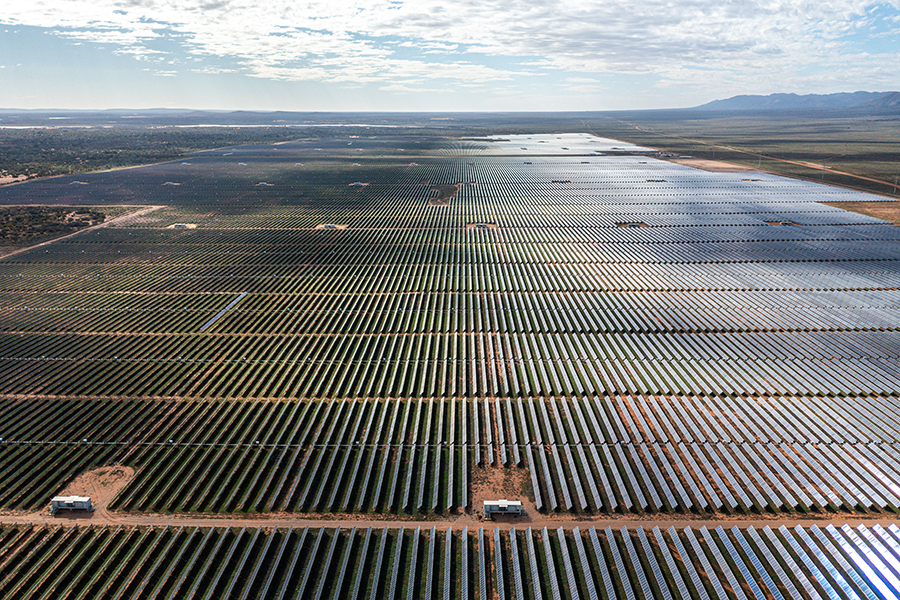Since 2015, the South Australian Government has been reporting its progress on climate impacts, risks and actions, making it one of the longest engaged subnational governments in CDP’s States and Regions disclosure. The state is home to just under 2 million people and has been a pioneer in the renewable energy transition. With a target of 100% net renewable energy generation by 2030, the state is well on track to achieving this, having gone from 1% renewable energy generation in 2007 to 68% in just over 15 years. Energy transformation is critical to the state’s decarbonisation. In May 2022, South Australia declared a climate emergency emphasising the state’s commitment to reducing emissions and mitigating the impacts of climate change.
Linking the renewable energy transition to economic opportunities by promoting innovation
As a former car manufacturing hub, South Australia is leveraging its transition to drive innovation, reskill workers and create green jobs for local communities. It is this push for innovation that has enabled South Australia to turn the renewable energy transition into an economic opportunity and empower citizens to be active participants in the transition. The state switched off its last coal-fired power generator in 2016 and now around 40% of homes have installed rooftop solar panels – the highest uptake in Australia, and, indeed, the world. The state also leads the nation in the uptake of residential home batteries, thanks to state and local government subsidies.
Investing in innovation has also enabled the state government to attract business, creating further economic opportunities. One such example is the development of the Hornsdale Power Reserve (HPR) grid-scale battery by Tesla and Neoen, the world's first, and formerly the largest, 100 megawatt (MW) battery to be built (in 2017), with an additional 50 MW installed in 2020. In mid-2022, in a world first, the HPR battery storage facility secured approval from the Australian Energy Market Operator to deliver inertia services to Australia’s National Electricity Market. The state has shown that batteries now have the capacity to provide these services at scale, as gas and coal fired generators have traditionally done.
Other examples of the state government’s continuous push for innovation and green investment and jobs include the establishment of the Tonsley Innovation District, on a former car manufacturing site, that brings high-value manufacturing and technology-based businesses together with the education and research sectors; and the development of Lot Fourteen in Adelaide into a global innovation neighbourhood of entrepreneurship, research collaboration and culture activity.
The state government is now focused on scaling a clean hydrogen industry and is investing more than three quarters of a billion Australian dollars to accelerate new hydrogen projects and shipping infrastructure. At the heart of its investment is a government owned and operated AUD 593 million hydrogen power plant being built near Whyalla, through the Hydrogen Jobs Plan. The plant will include 250 MWe of electrolysers, 200 MW of power generation, and fit for purpose storage facilities, and will be operational by December 2025. The Office of Hydrogen Power South Australia was established in May 2022 to oversee the delivery of the Plan. In addition, the state government was successful in its application to the Australian Government's Clean Hydrogen Industrial Hubs programme, with AUD 70 million committed towards the development of a hydrogen hub at Port Bonython in the Upper Spencer Gulf.

Bungala Solar
Empowering the community in the transition, including the most vulnerable
All the while, the state has been focused on ensuring that energy is affordable, equitable and does not disadvantage communities through increased costs. For example, the state government partnered with Tesla and Energy Locals to offer special tariffs for people in need of support when energy costs were high; and supported the installation of solar PV systems and Tesla household batteries as part of Tesla’s SA Virtual Power Plant (SA VPP) - the world's largest VPP on public housing. The VPP is one example of how the state government has been able to trial new technology in partnership with a global company, while at the same time bringing benefits to some of the most vulnerable in the community.
Building on the success of local council initiatives, South Australia’s Home Battery Scheme (HBS) was implemented in 2018 to support households to install VPP-capable home batteries, through government subsidies and low-interest loans provided by the Clean Energy Finance Corporation. Once all batteries associated with allocated subsidies have been installed, the HBS will have supported the installation of more than 22,000 batteries at homes across South Australia, totalling approximately 250 MW hours of behind-the-meter energy storage.
Accelerating action through leadership and transparency
Looking ahead, the state government is focusing on the green industrial transformation. The Heavy Industry Low-Carbon Transition Cooperative Research Centre (HILT CRC) supports research and innovation on how to decarbonise heavy industries. CRCs link companies with researchers to tackle the big challenges. In the HILT CRC, technology developers will be connected with end-users and other industries along the supply chain.
As a pioneer in the renewable energy transition, South Australia has not only been able to significantly reduce its emissions, but it has also turned this transformation into an opportunity for its economy, businesses, workers and communities. The Government is now able to transfer this knowledge and experience to the decarbonisation of other sectors, such as heavy industry, waste and agriculture, as well as apply its leadership to support climate action across the rest of the country, and globally. CDP will continue to track the progress and highlight key learnings of the South Australian Government’s efforts through our States and Regions disclosure.
Credit: Top banner image of Hornsdale Power Reserve by Neoen
